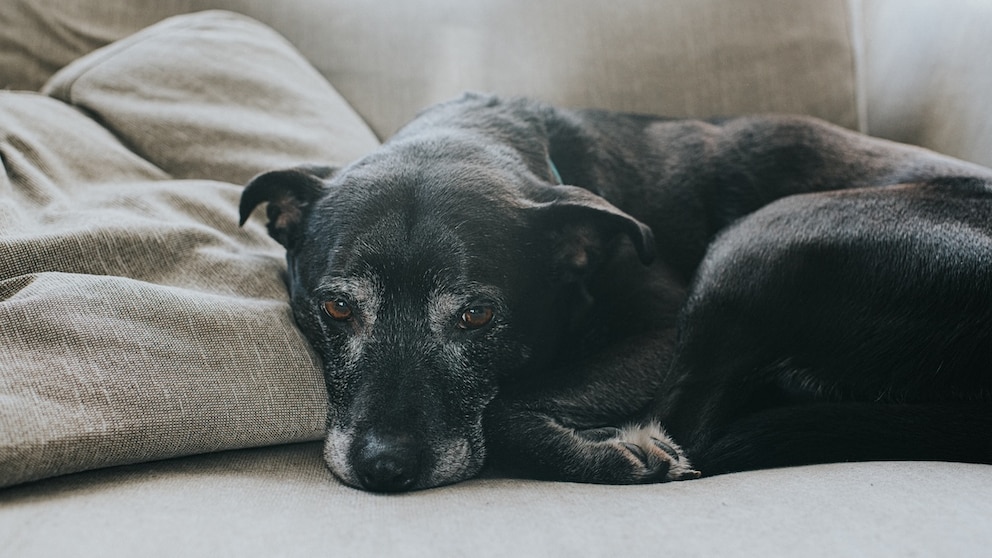
February 6, 2025, 3:37 pm | Read time: 5 minutes
As dogs get older, their everyday life changes – and that of their owners. Routines have to be adapted, special needs are taken into account, and time together is consciously organized. But how can you recognize a dog’s age? What care do they need, and how can you prepare for their departure?
Even our beloved four-legged friends get older. And the older your dog gets, the more challenging living together can be. The loyal companion can no longer maintain their former habits. Instead, it is important to create new routines when living with an old dog. Find out here how long dogs live, what signs they show as they get older, how to care for them properly, and how to recognize that a dog is about to die.
How Long Do Dogs Live?
On average, dogs live between 10 to 15 years, though their life expectancy varies based on numerous factors. Genetics, size, diet, care, environment, and the amount of exercise all play a major role. Rural dogs, for example, often live a little longer than their urban counterparts as they are exposed to less stress and have more space.
Larger dog breeds are already considered senior citizens at the age of five or six, while smaller dogs are only considered old from the age of nine. You can determine the age of a dog by looking at various signs. For example, the teeth or eyes reveal something about the age.
By the way, if you are considering adopting a dog, you should also consider the option of an older dog. It can be just as fulfilling to give a senior dog a loving home.
How to Recognize That a Dog Is Getting Old
Not every dog shows its age at first glance – some look young for longer and have gray hairs late in life, while others turn silvery earlier. However, it is, above all, the speed and joy of movement that diminish with age and make it clear that the dog is also getting older.
You can recognize when a dog is a senior by the following signs:
- Dog sleeps more than usual
- Dog moves more slowly
- Coat loses its shine and color
- Dental problems or bad breath
- Digestion slows down
- Dog no longer hears as well
- Eyes become cloudy or milky and they no longer see so well
- Dog becomes more susceptible to illness
Note: Some behaviors that are attributed to older dogs can also indicate diseases such as dementia. If your dog is suddenly no longer house-trained or has difficulty finding its way around, this is a sign that something is wrong. In such cases, you should definitely have any abnormalities checked out by a vet.
How Do You Deal with Old Dogs?
Senior dogs need extra love and care. An older dog has different needs than a young dog. In order to provide your pet with the best possible support when living with an old dog, and to ensure that you can still spend as much time together as possible, it is important to cater to their special requirements in everyday life.
To ensure that your older dog feels completely comfortable, it is important to adapt his home. Avoid climbing stairs to protect his joints. You should also pay attention to your dog’s needs when exercising. Adapt the intensity and type of exercise to his age and condition so that he doesn’t overexert himself and continues to enjoy exercise.
Living with an Old Dog – This Is What Matters
Older dogs are also less flexible when it comes to changes in their environment. Therefore, introduce your four-legged friend to new situations slowly or – if possible – avoid major changes. Contact with other dogs can also be important for older dogs. They need social contact to feel safe and comfortable – look for dog buddies who are good for them and don’t take up too much energy.
In addition, owners who live with old dogs should definitely make an appointment for a complete check-up at the vet. There, you will not only get a comprehensive examination but also practical tips for a possible change in diet.
How Does Death Announce Itself in Dogs?
Most pet owners don’t even want to imagine this scenario: their beloved four-legged friend is dying. There are several signs that indicate the imminent death of a dog. If you know your pet well, you won’t miss the warning signs.
If the following symptoms occur, you should contact the vet immediately:
- Lethargy and weakness
- Sunken face and/or severe underweight
- Refusal to eat and drink
- No mobility
- The dog’s organs stop functioning, often leading to kidney or liver failure in the final stages
- Bowel and bladder can no longer be controlled
- Pain
- Breathing and heartbeat become weaker
- Anxious or confused behavior
- Mucous membranes and mouth dry out
If your dog is slowly saying goodbye, it is important that you prepare for this together with your family. Give your dog as much closeness and support as possible in the last days and hours.

When Is a Dog a Senior Dog? Study Provides the Answer

What you should bear in mind when exercising with older dogs

Should I get a second dog? A dog trainer’s advice
How to Say Goodbye to Your Dog
Your dog has spent many years with you. Now, it is important not to leave him alone. Stay close to him, give him cuddles, and respect his needs. Some dogs seek closeness; others want to withdraw. If possible, spare him unnecessary pain and agony.
In some cases, it is better to euthanize the dog than to let it suffer for days. Your vet will be at your side during this difficult time and help you make the right decision.
Allow yourself ample time to grieve after your dog’s passing. In addition to saying farewell, you should also inquire about burial options and the process for deregistering from the dog tax.

